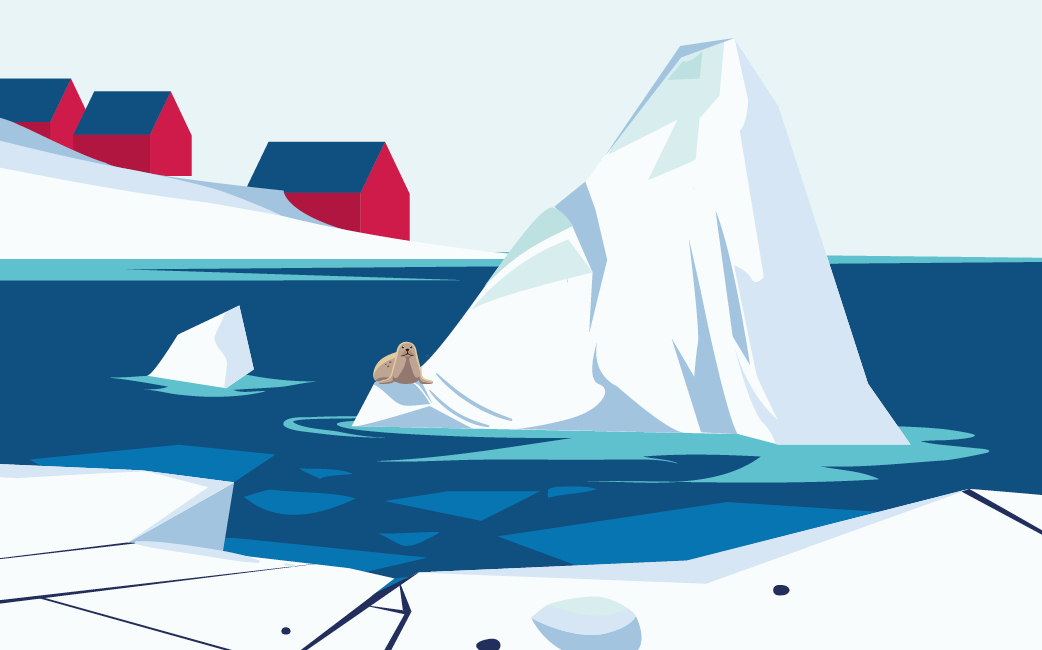The Greenland Ice Sheet, a huge expanse of ice at the far reaches of our planet, may feel remote and inaccessible – alien even – when we think about it. Despite this, just small amounts of ice melt will have, and in fact are already having, a significant impact on people who live near the coast across the world.
If all of Greenlands ice were all to melt, it would raise global sea levels by 7 metres.

The Greenland Ice Sheet is melting
Greenland is the largest island in the world: covered in ice, thick enough in places to bury mountains, it is roughly 10 times the size of the UK. If all of its ice were all to melt, Greenland would raise global sea levels by 7 metres. Although this will not happen for thousands of years at least – Greenland’s ice is declining now, and faster than we expected. Thanks to satellite observations of Greenland’s changing thickness, flow and gravity, we know it has lost almost 4 trillion tonnes of ice in the past 25 years alone. It can be hard to imagine how much ice that actually is – if you put it all into a single ice block it would be 16 kilometres along each side, and twice the height of Mount Everest!

^ Surface meltwater is transported towards the ocean in channels which form over several summers. Credit: Ian Joughin
How does an ice sheet “lose” ice?
In Greenland this occurs in one of two ways. As glaciers warm they flow faster into the ocean through funnel-like outlets at the ice sheet edge and calve off icebergs (which look like the picture below). Unlike Antarctica, Greenland is further away from the pole which means it gets much warmer in the summer, and around half of its ice is lost because more ice melts than snow falls in the winter. Meltwater produced on the ice sheet surface flows downhill and into the ocean. Greenland is losing ice seven times faster today than it was in the 1990s: warm summers have become more frequent in Greenland resulting in periods of extreme melting. The summers of 2012 and 2019 were so warm that melting was seen across the entire ice sheet – this had never been observed previously in the 40+ years we have been monitoring Greenland with satellites.
For every centimetre rise in global sea levels another six million people are exposed to coastal flooding.

How will sea level rise affect us?
All of this water added to the ocean from Greenland has raised global sea levels by more than a centimetre. Although one centimetre may not sound like much, even small amounts of sea level rise put people who live in low-lying cities at risk of flooding when extreme weather coincides with high tides. And this does not include sea level rise from other sources: ice in Antarctica is also melting faster than ever, and the oceans are expanding as in a warming ocean water molecules move faster and take up more volume.
Sea levels are currently rising at a rate of around 3 millimetres per year: as the global climate warms the mean sea level will increase and storms will happen more often. Flood defences will be breached more easily and coastal flooding will happen more frequently. As a rule of thumb, for every centimetre rise in global sea levels another six million people are exposed to coastal flooding around the planet – so ice losses from Greenland have already had a large impact, and ice sheet losses are only expected to increase in the future.

^ A large iceberg that is one of many that get stranded in this shallow region in Disko Bay near the Greenlandic town of Ilulissat, where 4500 people live. Credit: Ian Joughin
What might happen in the future?
As oceans and the atmosphere warm the ice sheets will continue to melt, and the ocean will continue to expand. Although thermal expansion has been the largest source of historical sea level rise, ice sheet losses are expected to take over as the largest contributors this century. Governments are interested in knowing how much sea levels might rise in the future so they can plan ways in which they can protect our coastlines: not only do people live by the coast, they are home to important infrastructure, agriculture and many people go there on holiday. Because we understand the physics of glaciers, we can use computer programs to help us predict how Greenland will change in the future. When we compare what we have observed to these predictions, we find that Greenland is tracking the high-end climate warming scenario. If this trend were to continue, Greenland ice melting will raise sea levels by an extra 7 centimetres by the end of the century, causing 100 million people to be flooded each year (400 million in total due to all sea level rise).
While this makes for grim reading, it is not too late for us to act! By reducing our carbon emissions over the coming decades we can curb the worst effects of climate change. We can do this now through rapidly transitioning to sources of renewable energy and eliminating our dependency on cars. While the political will to do this may be lacking at the moment, we can change that if we act together.

^ Views of inundated areas in New Orleans following the failure of flood defences surrounding the city after Hurricane Katrina, 2005. Credit: NOAA
Learning resource
We have created learning notes to assist students and educators to further investigate the topics covered in this article. You can download the learning resource here »


